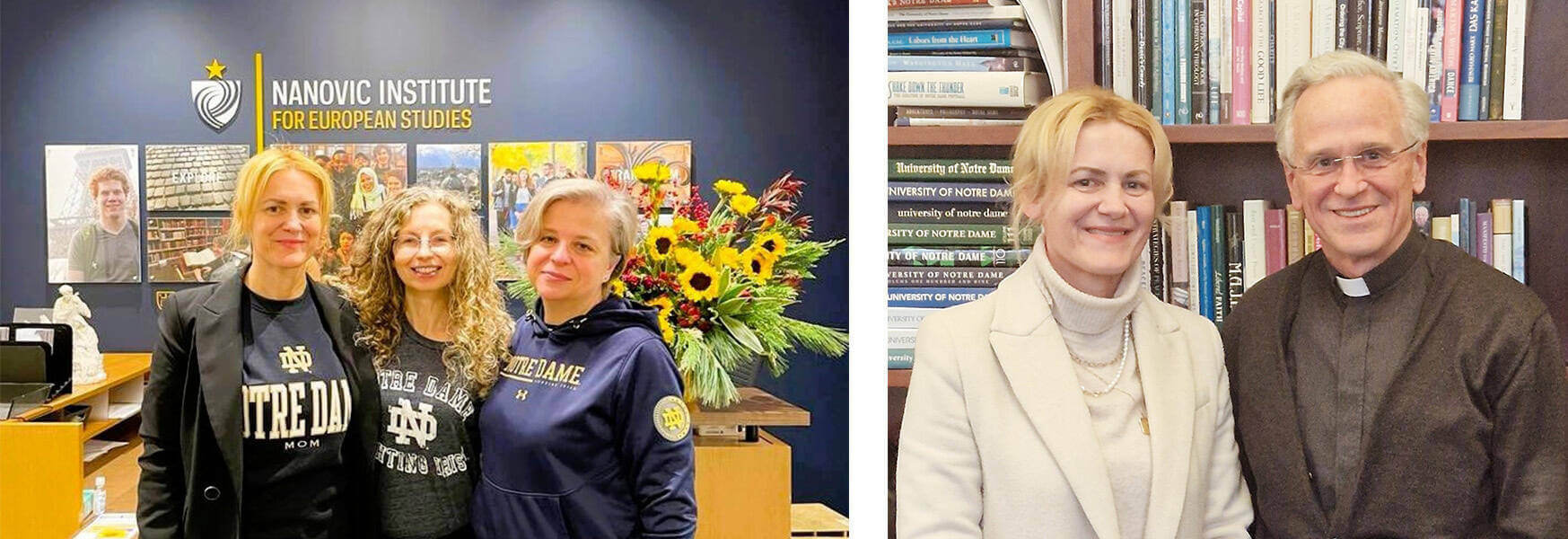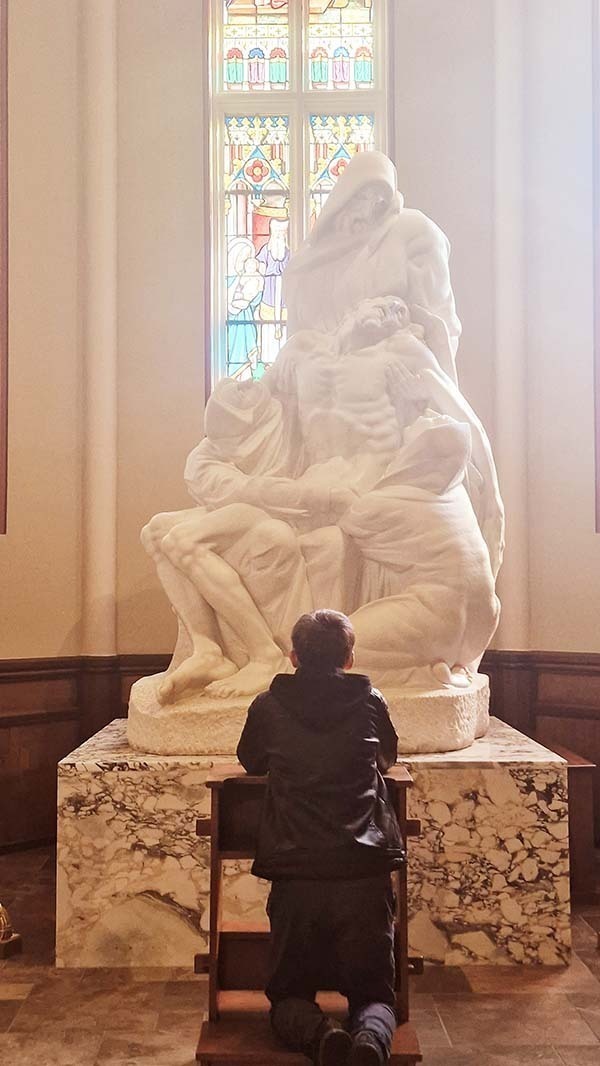
A visiting fellow’s journey to professional and personal enrichment.
Embarking on an extended international scholars’ journey was a unique opportunity for me and my family to delve deeper into a diverse academic and cultural world. Despite my openness to new challenges and academic opportunities, I vividly remember the initial concerns I had as a visiting scholar at Notre Dame. Two weeks before the journey, I was rethinking my decision as I worried about fitting in and, more importantly, how my children would adapt to a new cultural and linguistic environment. Surprisingly, these initial concerns transformed into a most enriching experience for both myself and my family.
During my stay at Notre Dame, my primary academic focus centered on the intricate relationship between ethics and memory. Specifically, I examined unwanted and contentious memories that individuals or societies often aim to eliminate or manipulate. This exploration included new technology, biomedicine, and various forms of collective action. Crucial aspects of my inquiry included discerning the ethical criteria applied when contemplating meta-memory and understanding how individuals and societies monitor their memory (re)constructions and narrative formations. The interdisciplinary approach encouraged at Notre Dame empowered me to transcend traditional disciplinary boundaries, facilitating a thorough exploration of the ethical implications woven into the complex fabric of memory studies.

Engaging with experts across diverse academic fields significantly broadened my perspective on this topic. I felt privileged to have the opportunity to visit Hesburgh Library and listen to lectures by esteemed scientists; some were organized by my host institution Nanovic Institute and others by the many other institutes, centers, and departments on campus. Although some presentations were not directly aligned with my topic, they greatly assisted me in reconsidering methodologies. Observing the engagement of the lecturers with the topics was truly enlightening, and I appreciated how their insights resonated not only within the Notre Dame academic community but also among students. It was inspiring to witness students, casually dressed in hooded shirts with the Notre Dame logo, fully engaged in campus life, delving into research and asking thoughtful questions.
Being part of a learning community
As I reflect on this chapter, I carry forward not only the wealth of knowledge acquired but also the enduring bonds forged.
I appreciated and am particularly grateful for the warm and welcoming atmosphere of the Nanovic Institute, led by Director Clemens Sedmak, who thoroughly read my research proposal, expressed interest in my topic, and provided invaluable suggestions. I am grateful to the entire Nanovic team: Rebekah Prince, Morgan Munsen, Abby Lewis, Grant Osborn, Peter Boyle, Keith Sayer, and especially Melanie Webb, who played a vital role in helping me with administrative issues upon my arrival in the USA. Special thanks to Fr. Jim Lies and Professor Hildegund Müller for their kind support outside Jenkins Nanovic Halls.
I am glad I happened to spend the semester at Notre Dame with Zoriana Rybchynska and Magda Charzynska-Wojcik, who were also serving as Visiting Scholars. With Zoriana I shared an interest in the culture of memory, and our cooperation will hopefully continue. As part of the wider Nanovic family, I am thankful for stimulating conversations with Jim McAdams, director emeritus of the Nanovic Institute and founder of the Catholic Universities Partnership, who expressed great interest in my country, and his wonderful wife Nancy, who volunteered in my daughter’s classroom. We discussed communism, monuments, memories, and education within their welcoming home. I appreciated discussions with David Buckley about topics related to my research, including American veterans’ traumatic memory, American society, and culture. I also enjoyed Friday morning coffees with interesting visiting scholars from the Kroc Institute for International Peace Studies, and I am grateful to Josefina Echavarría Alvarez and Norbert Koppensteiner for inviting me. A special acknowledgment to Nuno Moniz and Notre Dame IBM Technology Ethics Lab, where Moniz serves as director, for showing interest in my work, providing me with great ideas, and opening up new perspectives on the relationship between ethics, collective memory, and digital technology. Finally, I am thankful to the president of Notre Dame, Fr. John Jenkins, for finding time to briefly meet with me and hear about my research, despite his busy schedule.

Living on a campus where scholars are deeply committed to research and students to both study and sometimes sports creates a unique and dynamic environment. The fusion of intellectual pursuits and athletic dedication fosters a well-rounded community where excellence is celebrated in various forms. Engaging with visiting scholars from diverse academic and cultural backgrounds while living in Fischer Graduate Residences has enriched my understanding of many fields of study and fostered a more global perspective on research. These encounters go beyond the classroom or research setting; they extend to shared meals, informal discussions, and cultural exchanges.
The arts and community; learning across borders

Walking through the campus, one is also surrounded by art that adds another layer of richness to the campus experience. The presence of my compatriot Ivan Meštrović’s statues on campus is particularly inspiring. As I gazed upon these sculptures, the intricacy of Meštrović’s work resonated with me. Knowing about Meštrović’s humble beginnings and witnessing his remarkable success at Notre Dame evoked a sense of familiarity and pride. I was so pleased to show my children how artistic greatness can emerge from the most modest roots of our Croatian rural area. I felt blessed to attend the solemn liturgy at the beautiful Basilica of the Sacred Heart and later to have a family prayer in front of Meštrović’s Pietà, one of his most celebrated works of art.
As I navigated the educational landscape, I actively involved myself in local communities, took part in cultural events, and established connections that went beyond the boundaries of academia. Many thanks to the wonderful Albert, Haug, and Wang families for their support and special moments within their homes, and to the Notre Dame Tennis Club for kindly opening their doors for my son's practices. Delving into the local community and forming relationships outside the academic sphere not only deepened my understanding of American culture but also provided a more authentic perspective of America than what is often portrayed in the media. A distinctive aspect of my stay was the unique opportunity to witness American culture from a different vantage point – through the lens of public education. My children’s attendance at a local public school, Clay International Academy, provided me with a firsthand look into the vibrant and varied tapestry of American education. The juxtaposition of experiences between the public school setting and the esteemed halls of Notre Dame presented a nuanced perspective of American life. This duality allowed me to understand the multiplicity of narratives and challenges that shape the educational landscape in the United States. But it also helped me to reconsider and evaluate our education in Croatia in a new light. Coming from Catholic University of Croatia, which is a relatively young and small university, I appreciated even more what our leaders did and realized better the significance of our efforts within the broader universal context of educational struggles and achievements.
In conclusion, my experience at Notre Dame has been immensely enriching, and the knowledge gained during this chapter of my academic journey has been invaluable. I have formed great collaborations with esteemed scientists, but equally significant (or even more significant) were the friendships that blossomed during my time at Notre Dame. As I reflect on this chapter, I carry forward not only the wealth of knowledge acquired but also the enduring bonds forged.
Originally published by at crossingthesquare.nd.edu on April 16, 2024.